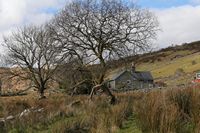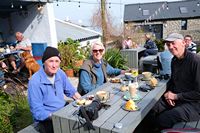Grumpy Old Men's Climbing Club 2025
- His fingernails, I see they're broken
- His ships, they're all on fire
- The moneylenders lovely little daughter
- She's eaten, eaten with desire.
- cohen
So, we made it. Breaking all my rules of past years, I stayed up past midnight to watch the London fireworks centred on the London Eye. Wow! Amazing. So here are a few of the pics I took from my television. No, I was not partying on the Embankment.
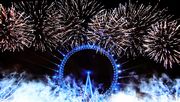


Strangely, I don't feel that bright this morning, it must have been something in the pigs-in-blankets flavoured crisps at the party last night.
While fine tuning our websites (yawn), I stumbled upon Desert Island Climbs from way back when in 2020. This seems to have slipped through the net. Check out our hopes and dreams (or nightmares) from times past on:
Click to open.
Outside it is cold and drizzly. Awesome Walls is cold and finger numbing. It's been like this for several days now and a certain depression is starting to set in. At night, my fevered brain torments me, at the keyboard I compose nonsense. FeverDreams.
Click to enlarge.
The good old days from Brian (Griffo) Griffiths.
1-4
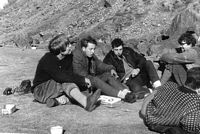
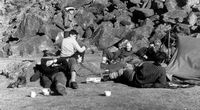

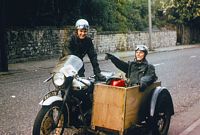
- Mike Richardson, Clive, Al Parker, Mike White, Chris Trotter, March 63
- SUMC, Andy Garvey, Phine, Grochan November 63.
- Paul Nunn on an early ascent of Sir Plum.
- Brian Griffiths, Rod Brown, Motorbike 1965
1-3
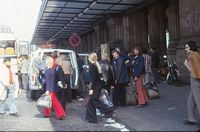
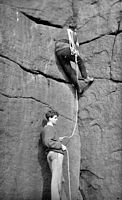

- ACG French trip 1975
- Griff, Dave Price, 1962
- Dave Peck, Mike White, Morris Oxide 1965.
Motorbike. Rod Brown and I leaving the Alpha doss on Crookesmoor Rd en-route for Wales.
The “notorious” ACG trip to the Vercor in 1975. Team featured Jack Street, Ken Jones, Al Wright, Speedy Smith, Paul Nunn, Rod Valentine, BG , A.N.Other (can’t remember who). Picture taken outside the Gare du Nord. The GHM (French) ream was headed up by Claude Deck (fair haired guy next to Paul). The trip featured a fracas on the night train from Calais to Paris, impromptu bivouacs, drunkenness (Brits, principally Jack and Ken, sabotaged two of the French team with liberal doses of Talisker. A sanitised version of the trip was published in Rocksport.
Dave Price – Dr Dave of “Double Declutch” (Agden) fame/notoriety when he pulled the finishing hold off and fell the length of the crag. Dave is still climbing, mostly indoors, at Awesome Walls, Stockport.
Finally, the Morris “Oxide” , our alps transportin the summer of ’65. Purchased from Mike White’s Dad for too much money. It broke down in Italy, had to pushed off the autostrada and a repair of sorts was effected with the help of an Italian garage. We with packets of Typhoo tea! It limped home on 3 cylinders and probably ended up in the scrap bay at ESC.
From Tom Westgate
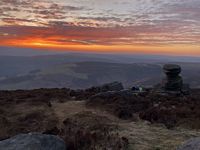
Above is a splendid sunset view of the Salt Cellar from Derwent Edge.
Ski Touring. The video shows Tom in the orange jacket in the hills above Livigno, Italy.
Chris and Sue in Wales, March 7th to 23rd.
Well, we probably can't compete with that, very little snow in Wales and sunsets were thin on the ground. However, we almost didn't get there at all. Sue was suffering with retching and lethargy, and I seemed to have gone down with something bronchial plus a soupçon of lethargy. This plague was almost certainly brought home from the Virgin gym by Sue.
Ever optimistic however, we packed up the camper van and set off, hoping for the best but prepared for the worse. And the best was right, days 1 and 2 were a bit of an effort but after that things steadily improved, and the weather was continuous sunshine for the two weeks that we were away. No rain! What is Wales coming to?
Our first campsite was at the West end of Llyn Tegid, which is the long lake starting at Bala and ending at Llanuwchllyn where our campsite resided next to the railway station at Pandy. The trains wern't running in March and the site was virtually empty. The main objective should have been the Aran ridge but as we were both a bit wobbly we opted for just a bit of it and then a sort of circular ramble to find our way back to the camper. We should have known better, rarely used footpaths drawn on the map with a ruler rarely exist,
1-5

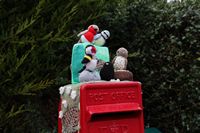

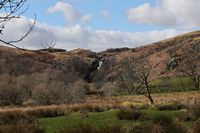
- Pandy railway station
- They're all of a twitter in Llanuwchllyn
- That's our campsite, the Buck rampant.
- Somewhere there is a footpath.
- The farm at the end of the world.
After 5 nights we moved on to the CAM campsite at Gellilydan which, despite the handbook labelling it as Ffestiog it was several miles away. Stlll, there was some excellent walking to be found around this delightful little campsite. North took us cross country onto the track of the Ffestiniog railway as far as Tanygrisiau then back through forestry and little yellow roads, 13 miles. Next day, spurred on by our new-found fitness. we then designed a walk which almost extended us above and beyond the kinaesthetic barrier. The circuit took along the shores of Llyn Trawsfynedd, then over the Cwm of the legendary magic pigs where I always assumed that bogs were more or less horizontal but this 30 degree slope broke all the rules. and then, following a dotted trail on the map which eventually became an actual trail. Eventually we traversed along Llyn Tecwyn Isaf and Uchaf to arrive, gasping at the old Maentwrog power station. Just another 3 miles of steady uphill. 14.5 miles! Ouch!
1-5
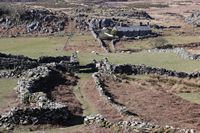

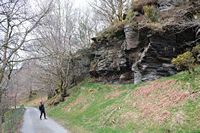

- The lonesome farms of the Cwm of the pigs.
- Wobbly walker on a wobbly bridge. Cwm Moch.
- Could this be the next crag X?
- As a member of the peeling paimt society I felt obliged to include this.
- Coltsfoots.
We moved on again, this time to gentle coastline of Anglesey at Coed-Y-Llwyn another CAM campsite. Nice site, the downside was that it was nearly 3 miles from the coast and the bus service was bordering on ficticious.
1-5

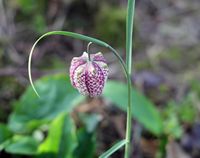
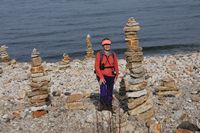
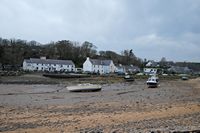
- Sue, resting on the waffle grid steps of a stile near Sychnant farm. Here, despite all the signs we took a turn for the worse and had to be redirected by a kind lady farmer on a quad bike.
- Snake's Head Fritillary.
- Cairn-builder-land on the coast of Anglesey
- Red Wharf bay
- While pottering along the coast path near Benlech we bumped into Les and Kerry Nailor whom we hadn't seen since the Parnassus Mountaineering Club 50th anniversary probably 20 years ago. They now live in Llandudno. Small world.
The Hubbards in Cyprus – Feb/March 2025
Why Cyprus at the end of February I hear you ask, as you well might. It has to do with carer cover that fitted around everyone else, it was winter at home and we wanted a break and Jan has a cousin who lives there (who she hadn’t seen for over 50 years) who assured us it would be just fine. So, we flew from Manchester at 14oC. At Paphos airport it was 6oC in the sun!
1-5
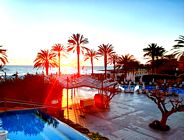

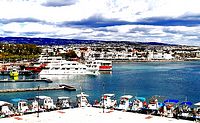
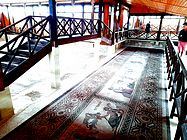

Pic 1 is the sunset from our balcony on the first evening. Sadly, Cyprus was having “an unseasonable” cold snap so, at 40C, we did not feel that a G & T out there was really on.Undeterred and wearing our winter woollies, we walked into Paphos port the next morning. Paphos has an ‘old town’ where very little is actually old. The only really old buildings look like modern fakes because they have been restored. In the port area, however, there are many really old parts, from the Greco-Roman period and also from the Byzantine period. Pic 2 is the inside of the Byzantine castle and Pic 3 is the view of Paphos harbour from its battlements. Adjacent to the harbour is the huge Kato Pafos archaeological site with the Tombs of the Kings a short bus ride up the coast. The main site contains about everything you would expect to find in the excavated ruins of the original Greek and then Roman city and much of it is absolutely stunning. Pic 4 shows a small part of the mosaics in the House of Dionysus and Pic 5 a remarkable mosaic that is solid enough to survive the rigours of the “unseasonable weather”. We spent getting on for three hours there because, as well as the extensive historical stuff, it also happens to be on the flightpath of the early migratory birds, of which there were many. Specials were a solitary whimbrel, a couple of bluethroats and a black redstart.
6-10
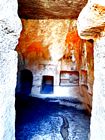
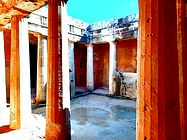
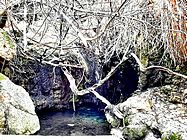
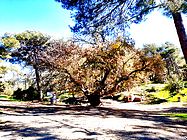
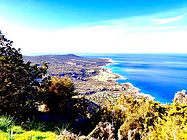
Up the road, Pic 6 is of one of best of the underground tombs, showing the burial niches in the wall. Pic 7 is from inside the most ornate, thought to have been the burial place of either/both Ptolomy and Cleopatra’s sister.
Filled with actual history, we decided to go for a stroll through Greek myth. On the Akamas Peninsula, which is scenically brilliant, is a round trip taking in Aphrodite’s bathing pool (where she frolicked with Adonis and Akamas), her oak tree (where she rested after bathing - she would have needed to as it’s a lengthy uphill walk from her pond) and the summit of Moutti tis Sotiras. The Rother guidebook suggested 2hrs 30 min for the whole thing. Herr Goetz mut have been running so, thereafter, we added a good 20% onto all of his timings. Pic 8 is Aphrodite’s bathing pool, which did not look at all inviting. Pic 9 is her oak tree, which is also the almost invisible site of a very ancient monastery and the cracking view of the peninsula from the top, Pic 10.
11-17

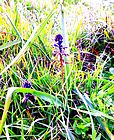
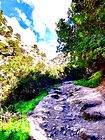

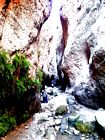
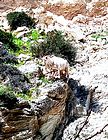
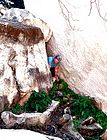
The peninsula is famous for its Spring flowers, so here are a couple of them. Pic 11 is Asphodelus aestivus and Pic 12 is Bellavalia trifoliata (asparagus family).
The next objective was the Avakas Gorge, a black route in Herr Goetz’s little book, which is sometimes closed due to rockfall or rain, which can fill it up. Undeterred, we drove along the coastal dirt ‘road’ to its mouth by a boulder beach and set off. After half an hour we encountered a sign telling us that the gorge was closed, due to dangerous rockfalls, but people were coming out of it without scars so we continued into it, Pic 13. The gorge is one of only three sites, worldwide, that contain the critically endangered Centaurea akamantis plant Pic 14. Even if it tried it could not be pollinated by specimens from the other two sites (in adjacent gorges) as they are incompatible sub-species. Without its flowers it is pretty underwhelming but was good to find – the label next to it did help a bit. Further in, the gorges narrows and the rock is very unstable, not helped by goats above Pics 15 & Pic 16. The route changes continually because of the rockfall and, in places, Pic 17, is distinctly awkward.
18-21


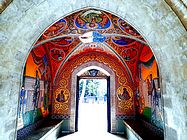
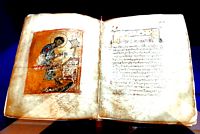
After a fairly scary hour, however, we emerged unscathed into the lovely upper meadows, Pic 18, which were full of goats. Not fancying Herr Goetz’s suggested circular route, which went for several kilometres through a forest and then three more along the dusty coastal ‘road’, we constructed a much better return through the upper meadows and down to the car. Ralph Goetz (still running) 3hr 30 mins for his longer route; intrepid Hubbards 4 hrs 30 mins for our shorter but much better option.
A trip to the top of the island was called for so we drove up to Troodos. It did not exist before 1924, when the newly installed British Governor of the island decided that Nicosia in the summer was far too hot for governing. So, he built some housing for governing, then some shops (because he realised that the nearest ones were 500m down the mountain on a very twisting road) that he persuaded some of the nearest locals to run and, finally, the church of Saint George (because he concluded that his governing required the assistance of the almighty). Only a British Governor could come up with a plan like that! So, they governed from Nicosia during the winter and from Troodos during the summer. A two-site shifting government base - now where have a come across that idea more recently? Pic 19 is a view of Olympos with snow on the top; enough for some snowmen and a ski club. Downhill for almost an hour brought us to the famous Kykkos Monastery, originally built in the 11th century. I was utterly breathtaking, in a slightly obscene sort of way, when you consider the sheer opulence of the place. Pic 20 is the frescoed entrance and the rest of it is covered in the same manner. Photography is not allowed in the church, which is filled with more frescoes and has a full-width altarpiece of pure gold and silver, from floor to the roof. There are more holy relics there than in the whole of Italy put together, I reckon. Whilst the bits of ‘finger’, the crucifixion cross etc are what they are, and I do respect the right of adherents to believe what they believe, there are other pieces in the museum that are extraordinary. For example, Pic 21 is a copy of most of the four Gospels written in Arabic. The outer pages have been lost, so the first part of one of them and the last part of another are gone but the book is accurately dated to the 4th century, so very early indeed.
22-26


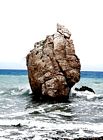


We went back to Troodos for a gentle stroll to the noted viewpoint of Makrya Kontarka, (Pic 23), passing a view across to the abandoned Amiantos asbestos mine, Pic 22, on the way. From here, on a really clear day, you can see two more Greek Cypriot mountain ranges, the Five Finger range in the Turkish north and all the way to the sea at Akrotiri. We couldn’t! On the way back to Pafos we popped into Petra tou Romiou to view Aphodite’s rock, Pic 24. It definitely looks like a head rising from the sea, about to become the lady herself and ready to float to the shore on a bed of flowers. We thought she appeared rather gnarly. What was Adonis thinking?
Our final walk was the Vouni Trail up to Profitis Ilias, here our extra 20% worked out exactly. This leads very steeply uphill for an hour, through terraced vineyards, then across the plateau via a tiny church, Pic 25 and more vineyards, Pic 26, then very steeply down through even more vineyards. The tiny church of Profitis Ilias amply illustrated the gulf between the opulence of Kykkos and the poverty of the little places. We met the local Greek Orthodox priest, at the church, who left his personal vineyard for a chat (probably to make sure we did not desecrate the place). He was very old, with a proper Greek Orthodox beard and a massively extensive knowledge of everything and everywhere around us. Fascinating.
As for Jan’s cousin, the short version is that a quick hospital trip for a very minor procedure turned into a bout of Covid, so we never did meet up. We are going back, next January (when we are assured that it will be fine ……..) for another attempt. Larnaka this time.



